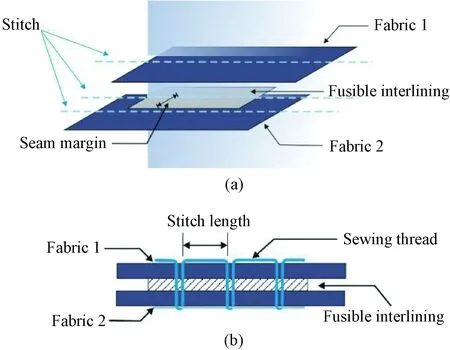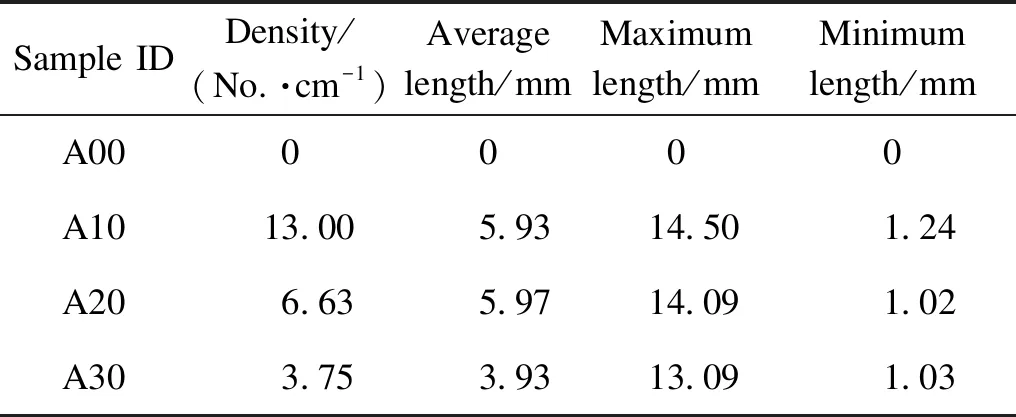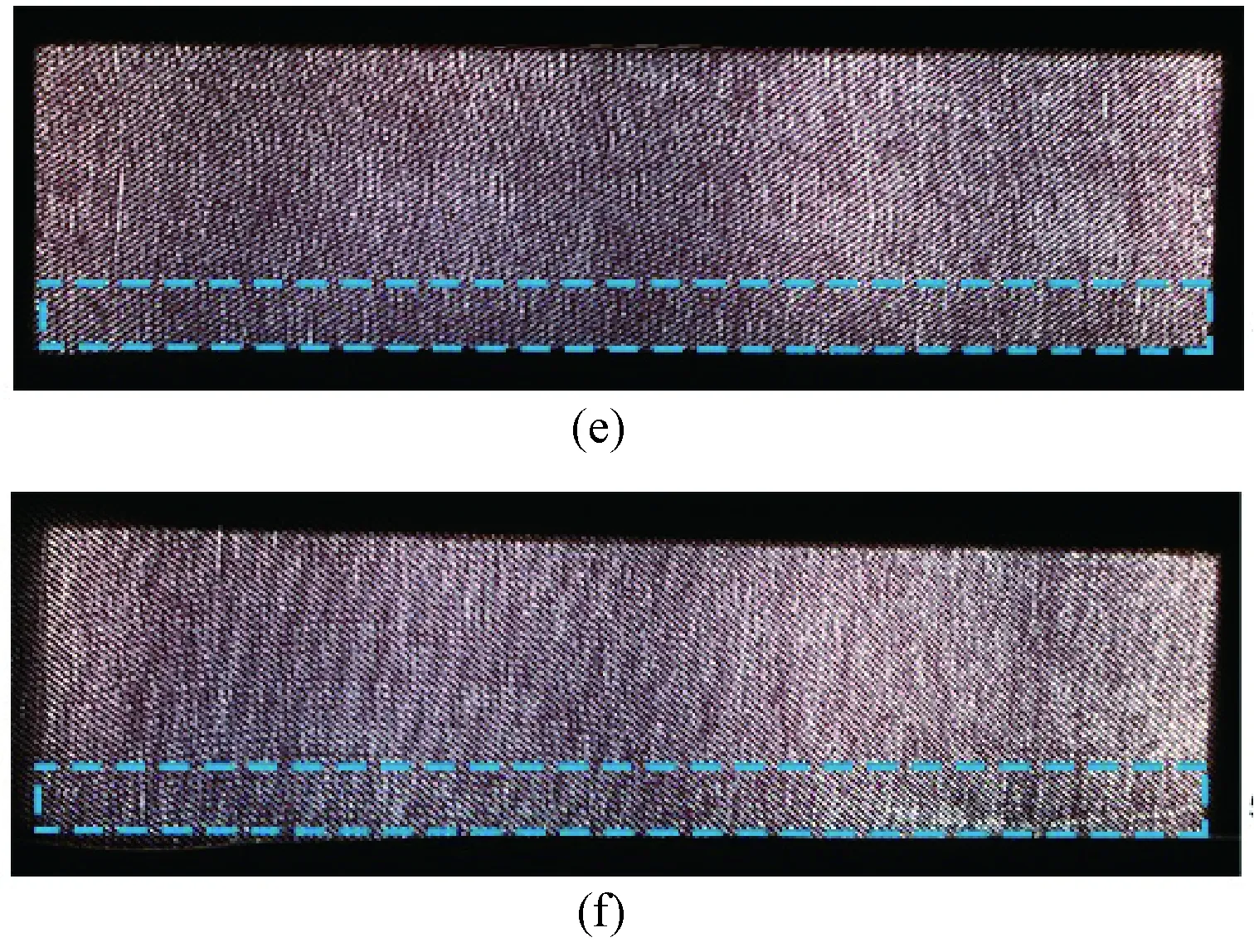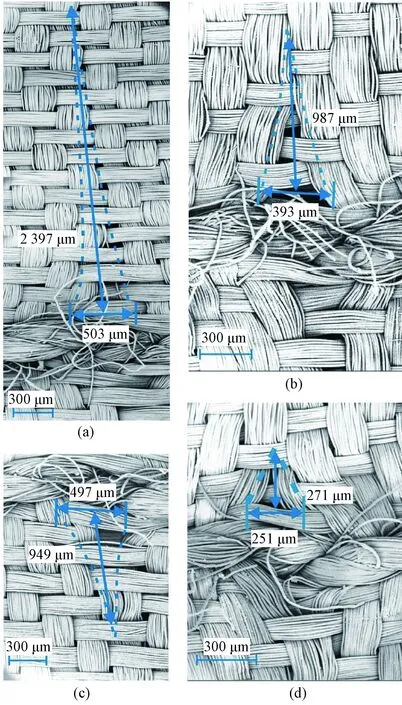Seam Damage Control and Image Analysis for Cuprammonium Fabrics
ZHANG YinjiaJIA XiaoshiCUI Lina3QIU Yiping4
1 College of Textiles and Apparel, Quanzhou Normal University, Quanzhou 362000, China2 Graduate School of Shinshu University, Ueda 386-8567, Japan3 Faculty of Textile Science and Technology, Shinshu University, Ueda 386-8567, Japan4 Department of Technical Textiles, College of Textiles, Donghua University, Shanghai 201620, China
Abstract: Cuprammonium fabrics are susceptible to punctuation of the sewing needle during the manufacturing processes of a garment. This type of punctuation splits the yarns in the fabrics, creates ladder-like sewing defects, and seriously affects the aesthetics of the finished garment. To minimize this seam damage, a sandwiched structure of cuprammonium fabrics with a fusible interlining was proposed to enhance the friction between the yarns in the fabrics. A measurement system was set up to evaluate the seam damage, and the effects of stitch length and seam width on the seam damage were studied. The seam damage tended to become less severe as the stitch length increased. The addition of the fusible interlining between two pieces of the fabrics could effectively suppress the seam damage. The seam margin should be below or equal to 5 mm for the stitch length of 2.0 mm. An excessive seam margin might lead to a distorted seam.
Key words: cuprammonium fabric; stitch length; seam damage; fusible interlining; inter-yarn friction
Introduction
Rayon and cuprammonium filaments become more and more popular because they have unique properties such as soft hand, air permeability, antistatic property, and other good characteristics[1]. The friction between filaments in rayon or cuprammonium fabrics is small due to the smooth surface of the filament. Therefore, in the garment sewing processes, the needle tip can easily push aside the neighboring yarns in the fabric, resulting in periodic seam damage due to yarn splitting, which looks like a ladder structure and may be named as laddering[2]. This may not be a serious problem if the fabric is just used as a lining material but it could be a quality issue for a regular garment, which is of great interest for designers and garment manufacturers[3-4]. Therefore, such seam damage should be well controlled if these fabrics have to be used as common garment materials. Seam damage has been studied extensively[5-9]. Choudharyetal.[4]summarized findings of studies on seam damage and defects in garments. Dorkin and Chamberlain[9]categorized seam damage into two types, namely yarn slippage and yarn fracture. They proposed a geometric model for calculation of yarn fracture due to needle insertion. Others have studied the influences of parameters on seam damage such as seam slippage, seam grinning, seam cracking, and open seam. Saurietal.[10]pointed out that seam damage depended not only upon the spaces in the fabric, but also on needle profile, needle size, sewing machine setting, and sewing thread. The influence of fibers, yarns, and weave on the seam damage has also been studied. Nayaketal.[11]analyzed the sewing performance of stretch denim and reported that the seam efficiency increased with Lycra percentage and the seam pucker, and the needle cutting index increased with the fabric mass instead of the amount of Lycra. Badr and El-Nahrawy[12]studied seam strength, seam pucker, and seam stiffness of knitted fabrics made from bamboo, modal, cotton, and modal/cotton blended fabrics with different fabric structures. Rogina-Car and Kovacevic[13]studied the damage to cotton fabrics during sewing with different needles and found that different needles could cause different damage to the fabric surface. Araletal.[14]investigated the seam damage for fabrics coated with heavy metals for an X-ray protective garment and found that a No.7 needle coated with gold would give the least damage to the fabric. Unfortunately, relatively few researches have been reported about controlling the kind of the seam damage for rayon and cuprammonium fabrics since fabrics are usually used as lining materials. In this research, we intend to control the laddering seam damage of cuprammonium fabrics during sewing through improvement of basic sewing processes.
1 Experiments
1.1 Materials
A cuprammonium twill fabric (warp yarn density and weft yarn density of 50 D × 75 D) was provided by Shanghai Nengtai Textile Co., Ltd., China. The light Chiffon double-sided fusible interlining (density of 30 D × 30 D) was provided by Changshu New Soochow Garment Accessories Co., Ltd., China. The sewing machine is the computer flat DDL-8900H produced by Dongguan Xingchi Sewing Equipment Co., Ltd., China.
1.2 Sample preparation
To study the effect of the seam damage by adjusting the stitch length of the fabric, the fabric was cut into a size of 100 mm × 50 mm, lined face to face, and sewed with stitch lengths of 1.0, 2.0, and 3.0 mm, respectively. For the garment industry, a stitch length beyond 3.0 mm is rarely adopted because such a large stitch length may result in low seam strength[15-20]. The samples were marked as A00, A10, A20, and A30 corresponding to non-sewn, and stitch lengths of 1.0, 2.0, and 3.0 mm, respectively.
A double-side fusible interlining sandwiched between two layers of cuprammonium fabrics and ironed at 135-140 ℃ with a pressure of 0.8-1.2 kg/cm2before sewing [shown in Fig.1(a)]. The stitched seam with the fusible interlining is illustrated in Fig. 1(b). Table 1 shows the samples used in the experiment. The so-called seam margin is defined as half of the interlining width [Fig.1(a)]. To investigate the effect of the stitch length, the seam margin was fixed at 5 mm, while the stitch length varied from 1.0 mm to 3.0 mm (samples were marked as B10, B15, B20, B25, and B30, respectively). In order to determine the effect of the width of fusible interlining, five seam margins were applied for a constant stitch length of 2.0 mm(samples were marked as C03, C05, C10, C15, and C20, respectively) as shown in Table 1.

Fig. 1 Schematic of sample preparation: (a) fusible interlining sandwiched between two layers of fabrics; (b) stitched seam with fabric-interlining-fabric laminated structure

Table 1 Samples for seam damage evaluation
1.3 Seam damage detection system
To measure the seam damage of the fabrics, a detection system was set up as shown in Fig. 2. It was composed of a shot box (60 cm × 60 cm × 60 cm), a camera (Canon 500 D, Japan), a back panel containing a LED light-emitting board, a layer of a light diffuser, and an adjustable rectangle detection window (8 cm × 2 cm). Since the seam damage for cuprammonium fabrics is resulted from the separation of neighboring yarns, leaving an enlarged gap between the yarns, it is assumed that the transmission of light through the fabric is proportional to the degree of the seam damage. The camera was set 80 cm away from the detection window, and camera lens was parallel to the LED light. Photographs of the samples were taken by the camera. The seam damage parameters were measured using the Image-Pro Plus software(Media Cybernetics, USA). The morphology of the fabric seam damage was also inspected by a scanning electron microscope (SEM, Phenom-Pharos, Netherlands).
2 Results and Discussion
2.1 Effect of stitch length on seam damage
Figure 3(a) shows the photograph of the unstitched fabric through which the transmission of the light is quite uniform. This could be marked as the control sample for comparing with the stitched samples. Figures 3(b)-3(d) are the samples sewed with stitch lengths of 1.0, 2.0, and 3.0 mm, respectively. The density, the average length, and maximum and minimum lengths of the cracks were presented in Table 2. It showed that the seam damage tended to become less severe as the stitch length increased because the frequency of stitching decreased per unit centimeter of the seam. For these samples, the more times the needle punched through the fabric, the more gaps were formed between the neighboring yarns. It shows how susceptible the fabric is to the seam damage without any prevention means.

Fig. 2 Detection system: (a) back panel assembly; (b) photography system

Fig. 3 Damage of unlaminated cuprammonium fabrics: (a) A00; (b) A10; (c) A20; (d) A30

Table 2 Damage data of unlaminated samples
2.2 Effect of fusible interlining on seam damage with different stitch lengths
To reduce the seam damage, a double-sided fusible interlining of 10 mm width,i.e.5 mm seam margin, was laminated between two layers of cuprammonium fabrics. The sandwiched fabric/interlining assembly was sewn with stitch lengths of 1.0, 1.5, 2.0, 2.5, and 3.0 mm. The appearance of the sewn seams is shown in Figs. 4(b)-4(f). Compared with the unstitched samples, the seam damage in the interlining laminated samples [shown in Figs. 4(b), 4(d) and 4(f)] was much less severe than those in their unlaminated counterparts with the same stitch lengths (1.0, 2.0, and 3.0 mm). As the stitch length increased, the cracks were less and less visible, especially for those sewn with a stitch length larger than 2.0 mm. Table 3 shows that the crack density tends to be lower as the stitch length increases. Compared with the unlaminated seams as shown in Table 2, the seam damage has been greatly diminished. It is concluded that the fusible interlining can indeed effectively suppress the seam damage.


Fig. 4 Samples laminated with interlining (5 mm seam margin) sewn with different stitch lengths: (a) A00; (b) B10; (c) B15; (d) B20; (e) B25; (f) B30

Table 3 Damage data of samples with different stitch lengths
2.3 Effect of seam margin on seam damage
To select a proper seam margin, samples with seam margins (half of the interlining width) of 3, 5, 10, 15, and 20 mm were prepared with a fixed stitch length of 2.0 mm. The appearance of the corresponding samples is shown in Figs. 5(b)-5(f). Compared with the unstitched sample A00 [shown in Fig. 5(a)], the seam damage gradually diminished as the seam margin increased. As shown in Table 4, there was a clear difference in the parameters of the damage when the seam margin increased to 5 mm and above compared with the unlaminated seams A20. The sample with a seam margin of 20 mm showed a certain degree of yarn distortion [shown in Fig. 5(f)]. This is most likely due to the influence of the interlining deformation during the ironing process which could deform the yarns in the fabrics if the seam margin was large enough[21]. It is concluded that the seam margin should be below or equal to 5 mm for the stitch length of 2.0 mm. For larger stitch lengths, the seam margin may further decrease. An excessive seam margin may lead to a distorted seam.


Fig. 5 Interlining laminated samples with different seam margins sewn with a stitch length of 2.0 mm: (a) A00; (b) C03; (c) C05; (d) C10; (e) C15; (f) C20 (positions of fusible interlining are indicated by blue dashed line frames)

Table 4 Damage data of samples with different seam margins
2.4 Mechanism of seam damage control by fusible interlining
As presented above, the seam damage for cuprammonium fabrics could be significantly suppressed using sandwiched fabric-interlining-fabric structures. The mechanism of the seam damage control for the proposed method has been explored. When the needle punctures the fabric, the yarn is either fractured or sliced or simply pushed aside corresponding to the location of the punctuation as characterized in Ref. [9]. When the yarn is simply pushed aside by the needle as the needle enters the fabric right in the space between the two neighboring yarns, the largest split gap can be created. Indeed, this phenomenon in the sample has been observed as shown in Fig. 6(a). On the one hand, if the needle punctures right on a yarn, the yarn could be fractured or sliced, and thus the split between the neighboring yarns will substantially decrease as shown in Fig. 6(c). The width of the inter-yarn crack is therefore determined by various factors. If the yarn has large stiffness, the gap can be larger since the torque generated by the bending of the yarn due to insertion of the needle will be larger. On the other hand, if the inter-yarn friction is large, the gap will be smaller because the yarn will have less mobility and be harder to be pushed aside for a visible length. This occurs when the yarn is made of staple fibers with a high coefficient of friction such as cotton and wool. For cuprammonium filament yarns, the bending stiffness is larger with low twist, and inter yarn friction is small. The crack will be larger, and thus the seam damage will be more severe.

Fig. 6 SEM seam damage images of cuprammonium fabrics before and after application of sandwiched interlining: (a) unlaminated fabric and (b) laminated fabric with needle right in the space between two neighboring yarns; (c) unlaminated fabric and (d) laminated fabric with needle right on a yarn
Fabric weave could be another important factor since it will determine the inter-yarn friction. In general, plain weave should have the highest inter-yarn friction while sateen weave should have the lowest, because the former has the highest interlacing point density while the later has the lowest one. Other factors, such as needle thickness, yarn linear density, and fabric count, could also affect the seam damage due to yarn split. All these factors should be systematically studied in future research. The way to prevent this kind of fabric seam damage is to increase inter-yarn friction.
In the current study, a fusible interlining was applied to fix the yarns in the fabrics on both sides of the seam. This seems to be very effective as shown in Figs. 6(b) and 6(d). Some other approaches may also be effective as long as the inter-yarn friction can effectively increase. The problem with usage of the interlining is that the stiffness of the seams may not be acceptable for many garments. This means that the interlining have to be somehow remove after sewing. It could be achieved by water soluble interlining materials.
3 Conclusions
To control the seam damage of cuprammonium fabrics, a group of sewing experiments were carried out. The seam damage tended to become less severe as the stitch length increased because the frequency of stitching decreased per unit length of the seam. When the seam was constructed by sandwiched fusible interlining between the two pieces of fabrics, the seam damage could indeed be effectively suppressed. The seam margin, half of the interlining width, should be below or equal to 5 mm for the stitch length of 2.0 mm. For larger stitch lengths, the seam margin may further decrease. An excessive seam margin may lead to a distorted seam.
 Journal of Donghua University(English Edition)2021年6期
Journal of Donghua University(English Edition)2021年6期
- Journal of Donghua University(English Edition)的其它文章
- Strain Pseudomonas putida PAO-1 Isolate with Polyphosphate Accumulating and Elongation Ability
- Theoretical Model on Transformation Factors of Scientific and Technological Achievements under the Belt and Road Initiative
- Exploitation of Waste Heat from a Solid Oxide Fuel Cell via an Alkali Metal Thermoelectric Converter and Electrochemical Cycles
- Gait Recognition System in Thermal Infrared Night Imaging by Using Deep Convolutional Neural Networks
- Feature Fusion Multi_XMNet Convolution Neural Network for Clothing Image Classification
- Data Augmentation Based Event Detection
